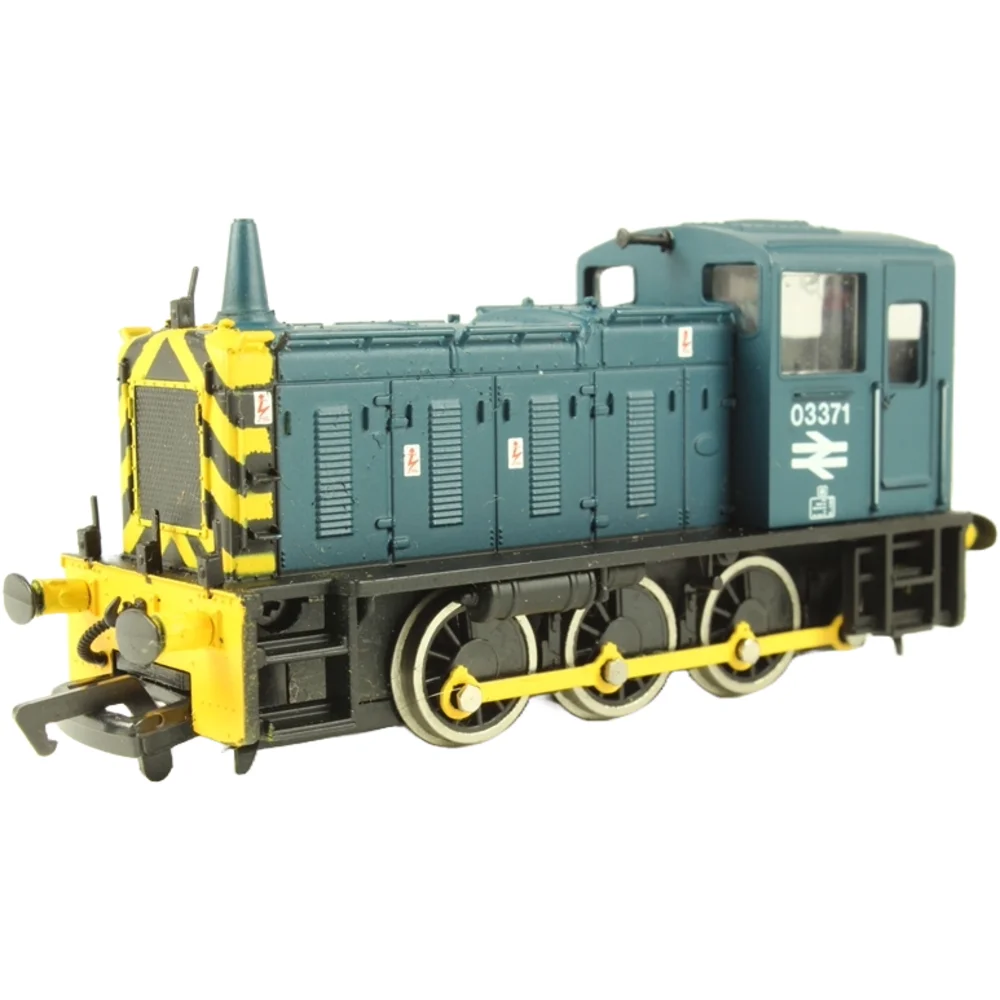Bachmann 31-352
British Rail Class 03 03371 British Rail Blue
Tooling
In 1991, Bachmann relaunched the British Rail Class 03 shunter in OO gauge using tooling inherited from Mainline (originally introduced in 1982). This marks the first iteration of Bachmann's Branchline Class 03, preceding later retoolings in 2010 and 2017. The model provided an affordable and accurate representation of BR’s small 0-6-0 diesel-mechanical locomotive as originally produced by Mainline, before Bachmann’s technical enhancements.
Tooling Features
- Scale: OO gauge (1:76), first-radius capable (minimum 371 mm diameter) – aligns with early Mainline design parameters.
- Construction: Plastic body shell with separate detailing (handrails, chimney, horn, lamps, windscreen wipers); die-cast chassis, split-style underframe from Mainline inheritance.
- Detailing: Cab interior with driver figure, glazing, buffer beams, pipework, sandboxes, and underframe components faithfully model the real Class 03.
- Couplings: Supplied with non-NEM tension-lock couplings permanently mounted to the chassis; conversion requires modification.
Mechanical & Electrical
- Motor & Drive: Retrofitted to a more reliable can motor within Bachmann tooling; jackshaft drive mechanism traces back to the Mainline system.
- Pickup & Wheels: Two-wheel pickup, all wheels driven for solid traction; chassis weighting ensures good adhesion.
- Minimum Radius: Handles first radius curves (371 mm) comfortably.
- Lighting: No built-in lighting on early tooling.
- Weighting: Die-cast chassis provides necessary ballast for smooth operation and pulling power.
DCC Capability
- Initial ex-Mainline variants (circa 1991) were DCC-incompatible, lacking sockets and decoder readiness.
- Later revisions prior to 2010 remained analogue-only; any DCC fitting required hardwiring.
Liveries Produced
Early Bachmann tooling saw production in:
- BR green with late crest;
- BR blue with “wasp stripes”;
- Depot-specific variations with accurate numbering.
Reviews & Commentary
- Praised for smooth running compared to Mainline predecessors, though still basic by modern standards.
- Detailing considered good for its era, especially cab glazing and handrails.
- Criticism focused on split-chassis reliability and lack of easy coupling upgrades.
Media & Social Media Insights
- Forum discussions note its suitability for small layouts thanks to first-radius capability.
- Collectors highlight its historical significance as Bachmann’s first UK diesel shunter tooling.
Other Interesting Information
- Recommended run-in period to settle gears and improve performance.
- Conversion to finer couplings often involved aftermarket kits or scratch modifications.
Class & Prototype
- Class: British Rail Class 03
- Traction: Diesel
- Transmission: Mechanical
- Built: 1957-1961
- Total Built: 230
The BR Class 03 was British Railways' standard light diesel-mechanical shunter, with 230 built at Doncaster and Swindon Works between 1957-1962. Powered by the legendary Gardner 8L3 engine and featuring distinctive jackshaft drive with coupling rods, these 30-ton locomotives excelled on weight-restricted lines, docks, and industrial sidings where heavier Class 08s couldn't operate. Notable variants included nine cut-down cab examples for the Burry Port & Gwendraeth Valley Railway and two for Isle of Wight tunnel clearance. With 56 preserved (24% survival rate) and the last example working until 2008, the Class 03 remains popular with heritage railways and modellers alike.
No prototype found.
Operator & Livery
- Operator: British Rail
- Livery: Blue
British Rail (1965-1997) transformed Britain's railways through revolutionary modernisation, introducing the iconic double arrow logo, Rail Blue livery, and business sectorisation. BR pioneered high-speed rail with the InterCity 125 and Advanced Passenger Train, electrified major routes, and created profitable divisions like InterCity and Network SouthEast. From steam succession through diesel and electric development to privatisation preparation, British Rail's diverse locomotive fleet, multiple livery schemes, and operational scenarios provide unparalleled variety for railway modellers across all scales and periods.
BR Blue, also known as Rail Blue or Monastral Blue, was introduced in 1965 as part of British Rail's comprehensive corporate identity overhaul that accompanied the rebranding from British Railways to British Rail. The colour was officially defined by British Standards BR28/6001 (airless spray finish) and BR28/5321 (brush finish), representing a dark, greyish blue tone specifically chosen to hide dirt and weathering effects well.
The livery was prototyped on the experimental XP64 train in 1964 before becoming the standard scheme from 1 January 1965. Rail Blue was applied to all diesel and electric locomotives with yellow warning panels (initially small, then extending to full yellow ends from 1966). The standardised application included the iconic double arrow logo and Rail Alphabet typeface, creating one of the most successful transport corporate identities of the 20th century.
The livery dominated British Rail operations for over two decades until sectorisation in the 1980s began fragmenting the unified appearance. Despite initial colour fading problems in early applications, these were resolved by the late 1970s when the Large Logo variant was introduced featuring extended yellow areas and full-height double arrow symbols. Rail Blue's enduring appeal among railway enthusiasts reflects its role as the definitive British Rail image during the organisation's most unified period.
